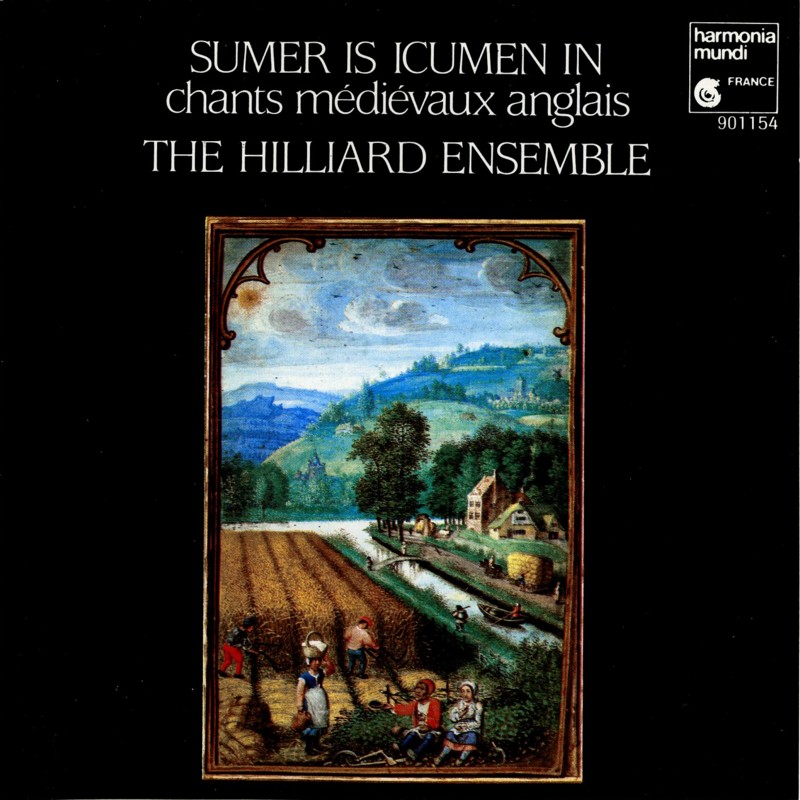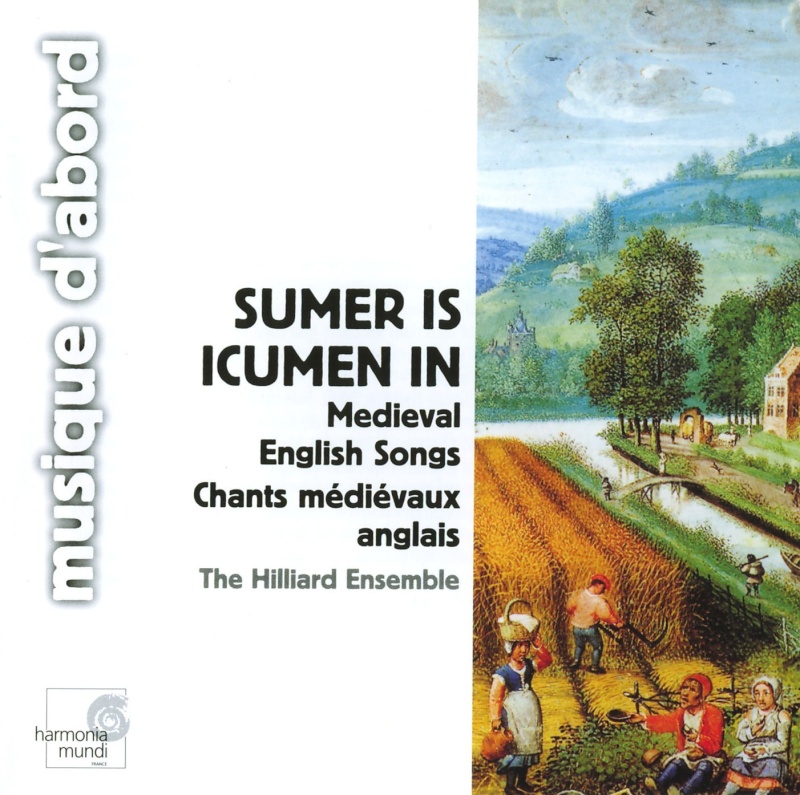Sumer is icumen in. Chant médiévaux anglais / The Hilliard Ensemble

medieval.org
Harmonia Mundi HMC 90 1154
septiembre de 1984
Anonymes du XIIIe siècles et antérieurs
01 - Sumer is icumen in [1:58]
St. GODRIC. Three Songs:
02 - Sainte Marie Viergene [1:37]
03 - Crist and Sainte Marie [2:12]
04 - Sainte Nicolas [0:41]
05 - Fuweles in the frith [0:41]
06 - Sancte Dei Preciose. V. Ut tuo propitiatus
[3:26]
07 - Alleluya. V. Nativitas [5:26]
08 - Kyrie. Rex virginum amator [4:23]
09 - Sanctus. Maria mater egregia [2:51]
10 - Agnus Dei. Factus homo [3:14]
11 - Perspice Christicola [1:26]
Anonymes de la fin du XIIIe au début du XIVe s.
12 - Companis cum cymbalis Honoremus Dominan [0:57]
13 - Mater ora filium [1:19]
14 - Edi be thu [3:38]
15 - Worldes blisse have good day (Benedicamus Domino)
[2:23]
16 - Valde mane diluculo [1:55]
17 - Gabriel fram heven-king [4:36]
18 - Stond wel moder under roode [7:06]
19 - Ovet mundus letabundus [3:44]
20 - Gaude virgo mater Christi [1:25]
21 - Campanis cum cymbalis [0:57]
The Hilliard Ensemble
Paul Hillier
David James, contre-ténor
Roger Covey-Crump, John Potter, Paul Elliot, ténors
Paul Hillier, Michael George, basses

THIS RECORD IS QUITE SIMPLY A RECITAL OF MEDIEVAL ENGLISH songs and
church music and reveals how blurred are any distinctions at this
period between sacred and secular «art» music. It is
similarly difficult, though not impossible, to distinguish between
English music as such and music (especially church music) imported from
France or at least showing strong French influence. In the vernacular
there are settings of English lyrics of course (though this does not
automatically guarantee an English musical thoroughbred); but compared
with the legacy of the troubadours, for example, or the northern French
trouvéres, there is remarkably little English secular music that
has survived the centuries. And while we cannot be certain just how
much originally existed, this paucity is due in part to the
predominance of Norman-French culture in both court and ecclesiastical
centres - precisely the places where one would look for an artistic
activity such as polyphonic composition.
That a native tradition did exist is certain, though we must normally
look to literature for a more definite expression of it. But whereas we
can turn from Chaucer and the French (and Italian) influence to the
more purely native tradition, superbly represented by «Sir
Gawayne and the Grene Knight», we have very little to turn to in
music that is specifically English. The reason why a search for music
of English origins is worth making is a simple one. The understanding
of any artistic heritage enriches our experience of the world. It is
not a question of superiority or inferiority, but at certain times
different cultures offer up something that is quintessential of
themselves. The aesthetic sense of freedom and grace that we find in
early medieval English art and literature can also be detected later in
its music. We hear moments of such music on this record.
I should like to record here a debt of gratitude to Professor Frank
Harrison, whose two important books «Music in
MedievalBritain» (London, 1963) and «MedievalEnglisb
Songs» (London, 1979), whose editions of some of the music and
whose generous advice have for some years now provided invaluable
assistance and encouragement in our performances of early English
music. Similarly we are grateful to the late Professor Eric Dobson
(co-author of «Medieval English Songs») for help with
pronunciation.
Sumer is icumen in
Easily the best known piece of medieval English music, this round for
four voices above a two-voice «pes» was probably written in
Reading Abbey around the year 1240. There are careful instructions for
performances and the music is underlayed with both Latin and English
texts. Although not the isolated miracle that some music historians
have suggested, it is nonetheless the only known six part music written
before the 15th century.
St Godric
Born in Norfolk, Godric spent the earlier years of his life as a
sea-faring merchant. He later made pilgrimages to Jerusalem and Rome
before withdrawing to a hermitage at Finchale, near Durham, on the
river Wear. Here he spent the remaining sixty (!) years of his life, at
first alone, later joined by his sister Burgwen and a servant. He died
on May 20th, 1170, tended by monks from Durham.
The three short songs appear to have been given him in visions, not
unlike the dream status of song in other cultures (e.g. American
Indian). One day the Virgin Mary appeared before him in his little
chapel, accompanied by St. Mary Magdalene, and taught himzm the first
song.
After his sister's death he prayed constantly for her soul, which
appeared before him on the altar together with two angels on either
side. Burgwen's soul then sang the second song to him, the angels
adding their Kyrie eleison.
The visitation of the third song is not known, though his biographer,
the monk Reginald, does mention that Godric sang loudly one night and
called out to St Nicholas, and later stated that the saint had visited
him and they had sung together.
Fuweles in the frith
A short early 13th century lyric in two-part descant style. The merging
of nature and personal emotion seem perhaps conventional enough, and
yet there is a freshness of effect that gives this motif a power that
later poets do not so readily achieve.
Sancte Dei preciose
Written c. 1100, probably in Canterbury for the monastery of St
Augustine, on a page at the end of a school book. The respond
«Sancte Dei» came after 2nd Vespers on Christmas Day. This
two-part setting of the Verse «Ut tuo propitiatus» can
fortunately be deciphered from the letter notation in which it is
written; whereas all too many extant fragments of this period survive
in an approximate pitch notation that cannot reliably be transcribed.
Alleluya V. Nativitas
A three-part 13th century organum in the style of the Parisian Notre
Dame school, setting the Alleluya of the Mass on the Feast of the
Nativity of the Blesed Virgin Mary. This is one of the earlier pieces
that has survived amongst the so-called Worcester Fragments, one of the
most important collections o fearly English polyphony. It includes a
direct quotation (the section «ex semine Abrahae... sine semine )
from Perotin's «Alleluya Nativitas». The hallmarks of the
style are clearly recognizable: lively upper voices above a sustained
drone and generally long notes ofthe «tenor» using the
notes of the original chant, the use of hocket and voice-exchange
(imitation), the clausula section where all voices including the tenor
move together.
Kyrie: Rex Virginum/Sanctus: Maria Mater/Agnus Dei: Factus Homo
These three two-voice settings of Mass movements, each troped
(interpolated) with a Marian text, are based on chants for the Saturday
Lady Mass. The music was probably written c.1270 for the Augustinian
Priory of St Andrew's and is included in a famous manuscript now at the
Herzog Bibliothek in Wolfenbüttel. Although these pieces are
probably of English origin, much of the St Andrew's music is French,
including works by Perotin, and is evidence of tbe considerable
importation and influence of French music at this time.
Perspice Christicola
A performance of the «Sumer» canon with its Latin text
celebrating the resurrection; Harrison has pointed out that the opening
of the pes melody is the same as for the chant «Regina
coeli», a Marian Eastertide antiphon.
Campanis cum cymbalis/Honoremus dominam
A short 14th century motet celebrating tbe jubilant power of music in
the praise of God; the second text honours the Virgin Mary. The lower
voices evoke the ringing of bells and the concluding chord unusually
contains a full major triad.
Mater ora filium
A short devotional setting of a Processional text, later used as a
Votive Antiphon; the plainsong is in the middle voice. Early 14th
century.
Edi be thu
This gymel (a composition for two equal voices) was written in the late
13th or early 14th century at the Augustinian Priory of Llanthony in
Gloucestershire. It is a songinpraise of the Virgin Mary and is
typically English in its extensive use of thirds.
Worldes blisse have good day /Benedicamus Domino
This song has survived on the flyleaf of an early 14th century
manuscript - a typical operation of chance in preserving an example of
medieval song. On the same flyleaf are a French motet and some wordless
three-part pieces. The song is technically a motet in which the lower,
textless part is an isorhythmic working of part of a plainsong
«Benedicamus» (this is here sungfirst as a solo chant).
Valde mane diluculo
This 14th century motet survives in the binding of a manuscript at
Tours. Harrison writes: «It is an intriguing mystery how the
French binders of a 15th century manuscript of the works of Terence
came to fix inside the binding some parchment leaves with the 14th
century motets of English origin. That the motets are English is
established by style, and the facts that one of them is previously
knownf rom an English source and that another has a Tenor part
indicated «Wynter», obviously the title of an English song.
Part of a possible explanation may lie in an interest in things English
on the part of the clergy who owned the main manuscript; for on two of
its insidepages are notes in French on some matters concerning the
history of England. The feature in a motet of having voices with the
same word or words, as in this piece, is also one that is particularly
English».
Gabriel fram heven-king
This 14th century song was extremely popular and survives in several
different versions. In this version for three voices, the
«tune» is sungby the middle voice. A Latin text also
survives - «Angelus ad Virginem» - and it is to this that
Chaucer is referring when he talks of Nicholas the Oxford Clerk in
«The Miller's Tale»:
And al above ther lay a gay sautrie
On which he made a-nyghtes melodie
So swetely that all the chambre rong,
And Angelus ad Virginem he song,
And after that he song the Kynges Noote.
Ful often blessed was his myrie throte.
Stond wel moder
A 13th century crucifixion lament which takes the form of a dialogue
between Christ on the cross and his mother, Mary. There are other
similar laments from the same period and, like the earlier Planctus and
Lai, they are of the genre known as Sequence, whose history begins with
Notker the Stammerer of St Gall (844-912). The essentials of this type
of composition are that the text is set for the most part syllabically,
and the verses rhyme in pairs, each new pair being set to new music.
The Sequence stands out amongst medieval song forms as one which
allowed musical development and construction on a relatively large
scale.
Ovet mundus letabundus
A 14th century motet for four voices in two sections, both repeated.
For the repeats the upper two voices are instructed to exchange parts
while the lower two voices simply repeat the same parts. Only the upper
voice is texted, the other parts are therefore vocalised.
Gaude Virgo Mater Christi
A 14th century three voice setting of the third and final strophe of
the sequence «Celum Deus inclinavit». The lowest voice is
based on a corresponding plainsong melody.
Campanis cum cymbalis
See above.
© PAUL HILLIER, 1985

